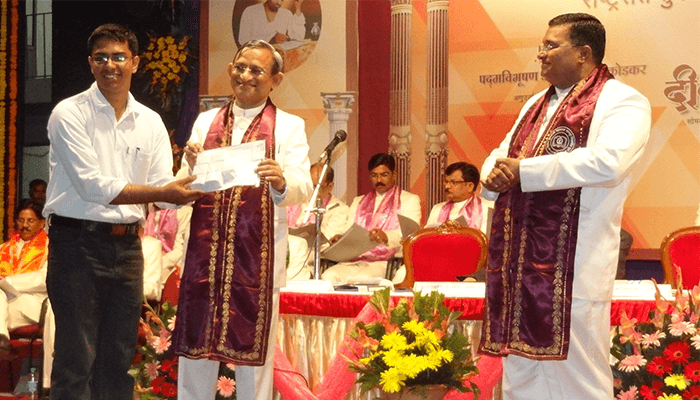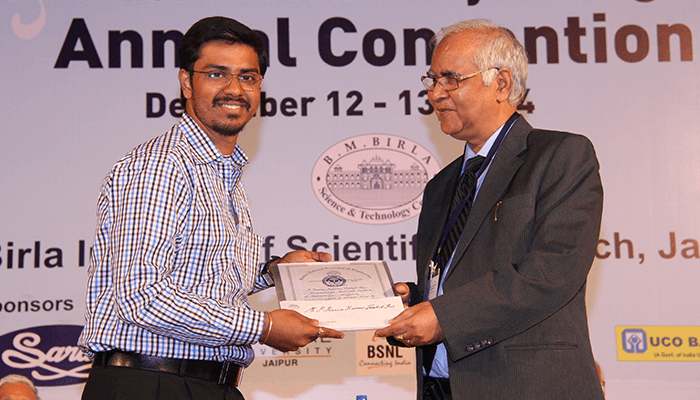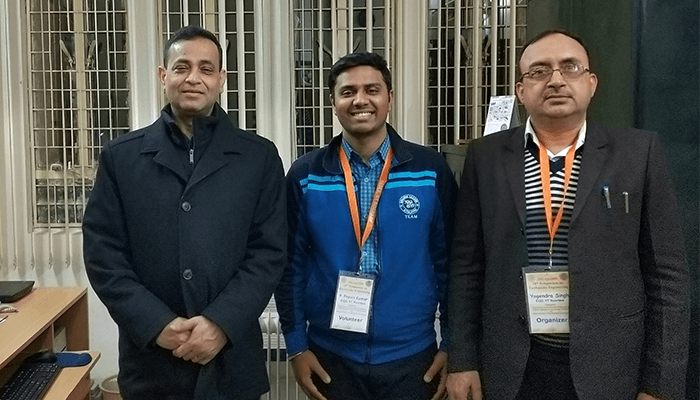It has been an eventful year for Prof Pravin Kumar Venkat Rao at IIITH. Recipient of the Promising Young Structural Engineer Award 2020 and the Young Engineer of The Year Award 2021, this 32-year-old accidental civil engineer has consistently been in the news almost every month. We find out why.
When the revamped Kolkata Town Hall is publicly unveiled in the next few months, Prof Pravin Kumar Venkat Rao from the Earthquake Engineering Research Centre at IIITH will have reason to smile. He was part of the IIT Roorkee team that had recommended retrofitting the 200-year-old historical structure and making it earthquake-resistant. The novel techniques implemented in the overhaul and strengthening of the Roman-Doric-styled building were based on Pravin’s doctoral research, which he completed at IIT Roorkee in 2019. His analysis was path-breaking, published a total of 16 research articles, including 7 journal papers, 7 peer-reviewed conference papers, and 2 book chapters, that has spurred academia and industry alike into recognising the need to safeguard heritage, traditional, and contemporary masonry structures.
Mad Over Masonry
Prof Pravin is an expert on the seismic safety of existing masonry buildings, which are usually made of brick, stone or adobe bound by mortar. With more than 85% of India’s building stock comprising of masonry, as per the 2011 Building Census, he says, “Such buildings which are predominantly located in moderate to high seismic zones are highly vulnerable to earthquakes.” His research developed three sustainable, innovative, and cost-effective techniques that can be used to reinforce masonry to withstand seismic forces. He used inorganic matrix (i.e., cement mortar) to develop wire and basalt fibre reinforced cementitious composite and organic matrix (i.e., epoxy resin and hardener) to develop basalt fibre reinforced polymer composite for strengthening masonry structures. Prof Pravin went on to validate the efficacy of composites at material, component, and structural level through an experimental investigation. In his research, he also developed a full-scale reversed cyclic test setup, which is the first of its own kind in India. “We simulated seismic forces with realistic boundary conditions to understand the behaviour of strengthened masonry walls along with the mechanical parameters to know the strength, deformation, and energy dissipation capacity.” Interestingly, he found that these techniques provide up to 16 times more strength when compared with unreinforced masonry. “The cost incurred for such reinforcement is very low, since the amount of reinforcement provided is very nominal,” he says. In addition to this, Prof Pravin also developed some analytical models that help in the prediction of lateral strength and also on vulnerability assessment of existing and reinforced masonry buildings in the event of earthquakes.
Currently, he is working on seismic safety assessment procedure and developing a design methodology for strengthening using ‘splint and bandage’ technique with wire mesh and recommendations for application procedures to on-site masonry buildings. He added “the developed method will be of significant importance in the context of assessment and mitigation of seismic risk for the masonry housing stock”.
Acclaim and Accolades
All of this has made the civil engineering community in the country take notice and it’s not surprising that he won the ‘Promising Structural Engineer Award’ from the Indian Association of Structural Engineers in 2020. More recently on the eve of National Engineers’ Day, he was conferred the Young Engineer Award by the Institution of Engineers (India), Telangana State Centre, a recognition of contributions made by young engineers not older than 35. All his journal research publications have been in SCI (Science Citation Index) Q1 journals – which means they rank amongst the top 25% journals in the same area. His consistent academic track record has also helped in garnering the latest feather in his cap – the approval of the ‘Startup Research Grant – SRG’ by the Science and Engineering Research Board, Department of Science and Technology (DST). It’s a 2-year-grant that helps researchers kickstart their careers in a new institution. “It’s for my project on using textile reinforced mortar composites for retrofitting masonry buildings. I’m also going to use this research fund to develop the Structural Engineering Lab at EERC,” states Prof. Pravin, revealing that he has another seed grant from IIITH that’ll help in upgrading the infrastructure at the lab.
Engineer by Chance
The multitude of accomplishments that have come his way rather early in his career, may make Prof. Pravin seem like the poster boy on building a dream career. But reality suggests otherwise: he didn’t even plan on becoming an engineer! “My dream was to be a train driver, like my father,” he says. Having lost his dad at the age of 11, he was promised the same job by the Indian Railways upon attaining majority. It was his mother who goaded him to upskill himself ‘technically’ so that the eventual transition to a bread-winner would be smooth. For this, he enrolled in a Government polytechnic college to gain a diploma soon after his 10th grade. The family had by then relocated from Kharagpur to Nagpur. “Based on my 10th grade marks, I was eligible only for Civil Engineering and hence got into this field,” he says of his tryst with the discipline. The “government job” never materialised. He was 16 when he was diagnosed with Anisometropic Amblyopia – a medical condition of the retina that can be treated only until the age of 12. “I have zero vision in my left eye,” says Dr. Pravin, adding that he was rejected by 7 central government organizations because he failed their medical exam. By then his exposure to civil engineering had fostered a desire to gain a formal BE degree. However, his financial situation forced him to compromise on his academic aspirations. “I obtained admission in VJTI, Mumbai, as I was the Maharashtra state topper in polytechnic, but had to let go of it since I couldn’t get hostel accommodation. Any other kind of accommodation was beyond my means,” he explains earnestly. This meant pursuing a BE in Civil Engineering from Nagpur University.
Building A Career
In Nagpur, with a tuition fee that seemed impossible to meet, Prof. Pravin struck a deal with the college authorities promising to stand first in every semester and to represent the college at national events – in return for an extended deadline in fee payment. He went on to keep his end of the bargain, scoring a distinction in every semester and became the overall university topper in all engineering streams and bagged 7 gold medals.

In addition, he won several national level technical events like paper presentations, quizzes, and best project award. As for the college, he says, “I’m very grateful to the authorities in extending support by letting me pay the fees only after I got placed at the end of the degree program”. Bitten by the academic bug, after a year’s worth of work experience at Larsen & Toubro, he appeared for the Graduate Aptitude Test in Engineering (GATE) to pursue his postgraduate studies. “I was getting a seat in IIT Kharagpur as well as in IIT Guwahati,” he says. But his mother’s ill health prompted him to decline both the offers, opting again for the city of Nagpur instead where he enrolled for an M.Tech. at Visvesvaraya National Institute of Technology (VNIT). It was here that he narrowed his focus onto Structural dynamics and Earthquake Engineering. “There are only around 4 institutes in the country that offer a specialised degree on earthquake engineering. VNIT is one of them,” he says. As a recipient of an MHRD scholarship that covered all expenses during his 2-year stint there, he culminated his Master’s as the college topper. His Master’s research work also got recognized through ‘Innovative student Project Award’ by Indian National Academy of Engineering.

Enthused by structures and their behaviours, Prof Pravin had his mind set on continuing his academic journey with a doctorate degree. He initially got admission into IIT Guwahati and had just completed 3.5 months at the Dept. of Civil Engineering when he had to abandon his plans in view of his mother’s deteriorating health. This time around, he didn’t want to compromise on the institution for his higher studies. “My professors advised me to pursue a doctorate in an IIT and nowhere else. So, 6 months after tending to my mother, I applied once again and was accepted at Dept. of Earthquake Engineering, IIT Roorkee. I took a bold decision to join,” he says, referring to the uncertain situation at home. Armed with another MHRD 5-year-scholarship, Prof. Pravin went on to do incredible research under Prof. Yogendra Singh and Prof. Sreekanta Das (University of Windsor) for which he is recognised and continues to be feted. “It was a great and fruitful experience working with both my mentors, and they played a significant role in shaping my career”, he smiles. He continued to work as a Research Associate at IIT Roorkee for a year before joining IIITH as an Assistant Professor in EERC.

All New: Courses, Equipment & More
At IIITH, Prof. Pravin has introduced two new courses for PG students – one on Earthquake Resistant Design of Masonry Structures and another on Theory of Elasticity. “Bachelors’ courses anywhere in the country do not teach masonry as such. That’s why students are unaware of the subject and the behaviour of these structures. With most of the building stock in the country falling under masonry, and therefore there is an urgent need for awareness about it and the problems associated with it. That’s why I’m motivating students to take up research in this area.” Calling masonry, the “common man’s housing”, Prof. Pravin plans to dedicate all his efforts towards it and excel in the domain. According to him, there’s a lot of grey area that needs to be worked on, especially at the material and component level of failure modes of masonry structures. His ultimate goal is to develop expertise in the field of seismic safety of existing masonry structures and prepare guidelines that will be considered by the Bureau of Standards (BIS). For now, he’s learning to balance between his health, family, teaching and research – in that order of importance. At last, he says “Today whatever, I am its because of my mother’s sacrifices, without her guidance and support, it could not be possible.”




Next post